The Power of Visual Effects in Post-Production: Transforming Filmmaking

When you think about why filmmakers add visual effects in post-production, it’s evident that they play an essential role in enhancing the overall storytelling experience.
By integrating VFX, you can create environments that feel incredibly real and achieve shots that would be impossible to capture naturally.
This not only improves visual continuity but also allows for the addition of creative elements that can elevate the entire narrative.
Imagine the possibilities for engaging audiences and increasing production value.
But how exactly do these effects save time and costs while expanding creative horizons?
Table of Contents
Enhance Storytelling
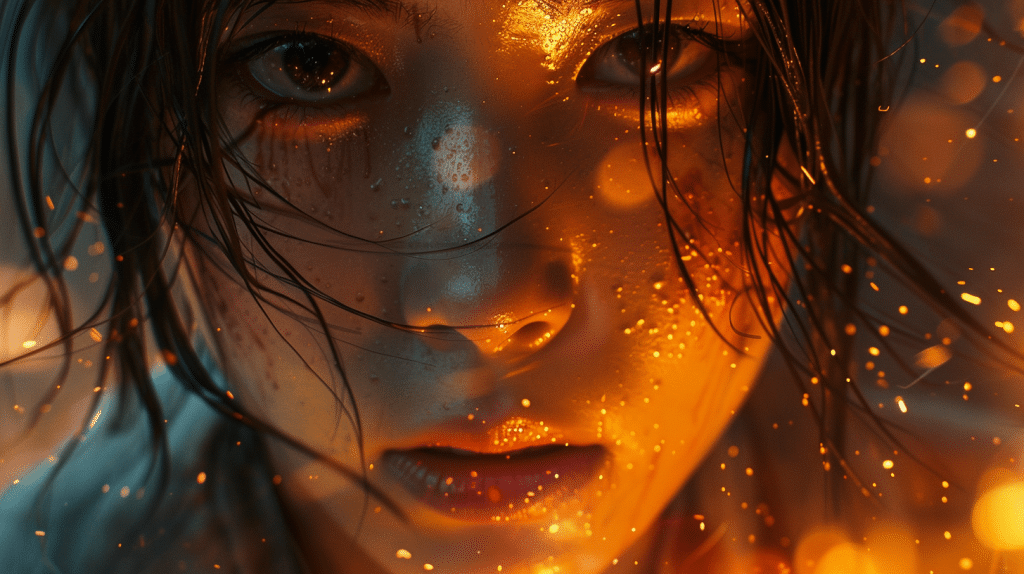
By incorporating visual effects in post-production, you can greatly enhance storytelling by creating immersive and emotionally resonant scenes.
Visual effects allow you to amplify character emotions, making their feelings more palpable to the audience.
For instance, subtle changes in lighting or color grading can intensify a character’s despair or joy, guaranteeing that viewers connect on a deeper emotional level.
You can also use visual effects to control narrative pacing effectively.
Want to slow down a moment to emphasize its importance? Add a slow-motion effect to make the scene linger in the audience’s mind.
Conversely, you can accelerate scenes to heighten tension or excitement, keeping viewers on the edge of their seats.
The seamless integration of these effects ensures that the story flows naturally, maintaining the audience’s engagement throughout.
Moreover, visual effects can serve as a tool to visually symbolize a character’s internal struggles or transformations. By doing so, you add layers of meaning to your narrative, making it richer and more compelling.
With precise application, visual effects become an indispensable asset in crafting stories that resonate emotionally and sustain a gripping narrative pace.
Create Realistic Environments
To create realistic environments, you’ll need to master simulating natural landscapes and enhancing urban settings.
Use advanced software like Unreal Engine or Blender to generate convincing terrains, foliage, and weather effects.
For urban scenes, integrate detailed architectural models, dynamic lighting, and accurate street layouts to bring the city to life.
Simulate Natural Landscapes
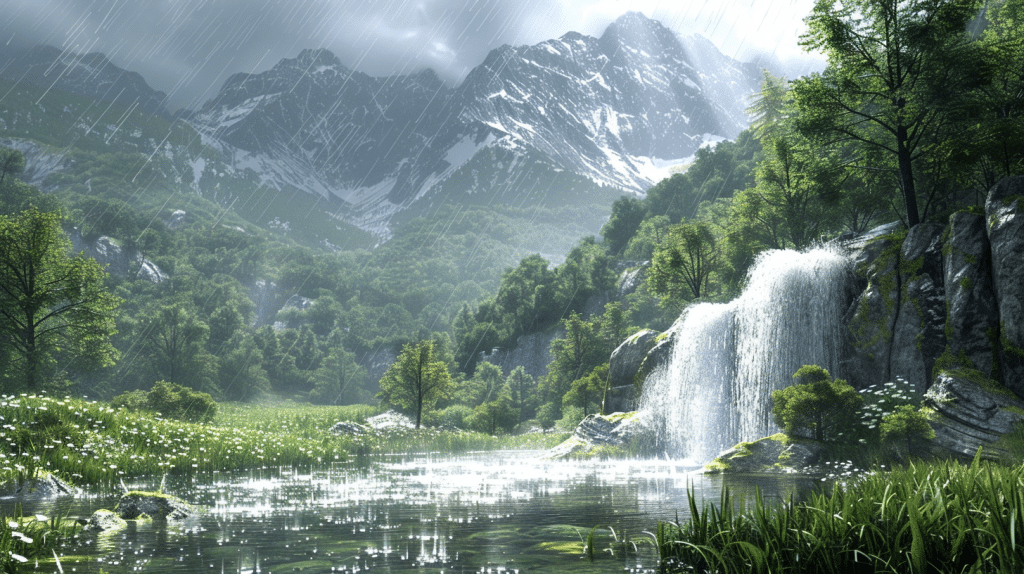
Creating realistic environments often requires a deep understanding of natural elements and the skillful use of advanced visual effects software. To simulate natural landscapes, you need to master weather simulation and terrain morphing.
Weather simulation allows you to create dynamic weather conditions like rain, snow, and fog, adding layers of realism to your scenes. By controlling these elements, you can evoke specific moods and atmospheres, enhancing the emotional impact of your visuals.
Terrain morphing is equally essential. This technique lets you transform flat surfaces into complex terrains, complete with hills, valleys, and other geographical features.
Using software like Houdini or Terragen, you can manipulate digital landscapes to match your creative vision.
It’s not just about making the terrain look good; it’s about ensuring it behaves naturally, responding to elements like wind and water flow.
When you combine these techniques, you can create breathtaking natural environments that are both aesthetically compelling and scientifically accurate. This level of detail elevates your project, making it stand out in a crowded market.
Enhance Urban Settings
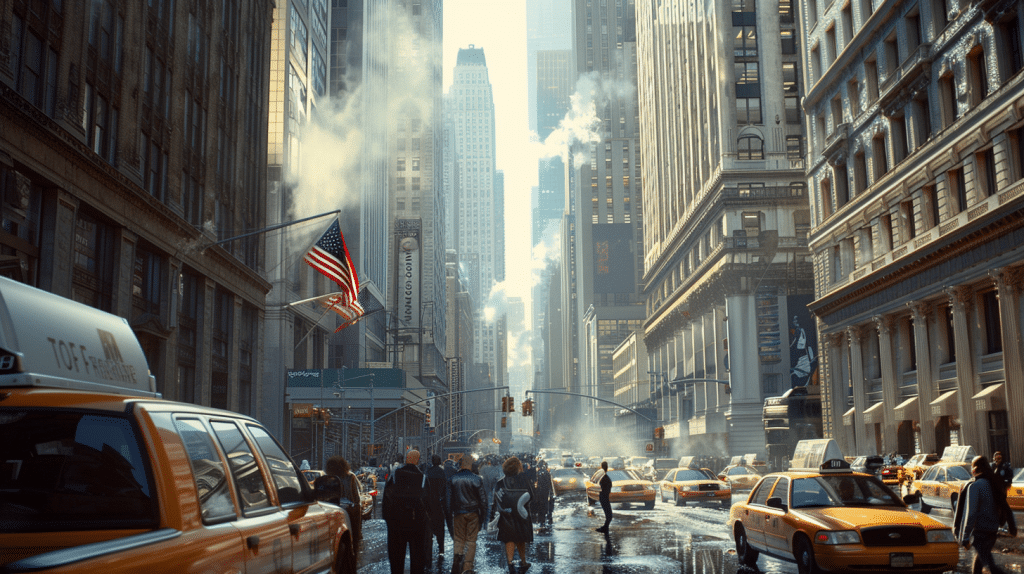
Transforming urban settings into visually compelling and realistic environments demands a meticulous blend of architectural accuracy and creative flair. You need to capture the intricate urban dynamics, from the bustle of crowded streets to the subtleties of architectural details.
Post-production visual effects (VFX) are indispensable for achieving this level of realism. By leveraging advanced VFX techniques, you can enhance cityscapes, making them appear both authentic and engaging.
City transformations in post-production allow you to manipulate urban environments in ways that would be impossible or prohibitively expensive to achieve in real life.
You can modify skylines, adjust building heights, and even alter the time of day to suit the narrative requirements. Adding elements like moving traffic, digital pedestrians, and atmospheric effects such as fog or rain can breathe life into otherwise static scenes.
When you aim to create realistic environments, attention to detail is paramount. Using VFX, you can seamlessly integrate CGI elements with live-action footage, ensuring that lighting, shadows, and textures match perfectly.
This level of precision not only enhances the visual appeal but also maintains the viewer’s suspension of disbelief, allowing for a more immersive and enthralling urban experience.
Achieve Impossible Shots
You can achieve impossible shots by using visual effects to enhance your creative vision and transcend physical limitations.
By integrating CGI and advanced compositing techniques, you’ll create scenes that transport audiences into domains of magical realism.
This approach not only expands storytelling possibilities but also elevates production value to new heights.
Enhance Creative Vision
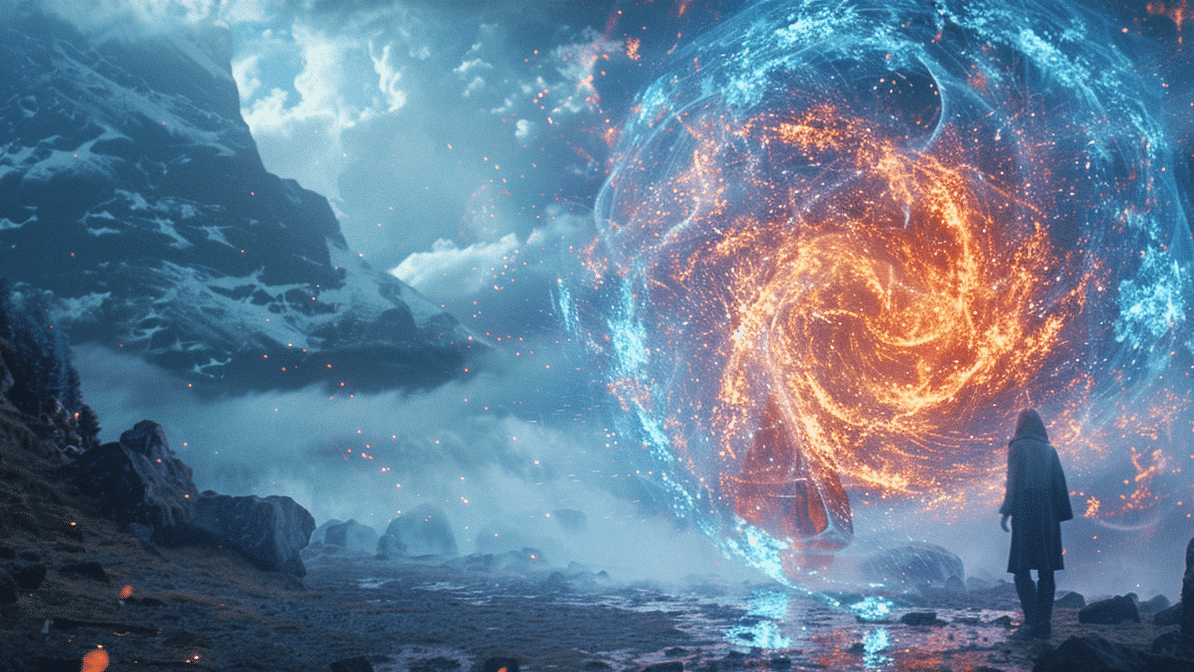
Mastering visual effects in post-production allows filmmakers to achieve shots that defy the constraints of reality and practical filming.
You can visualize an entire world that doesn’t exist and bring it to life through meticulous artist collaboration and vision refinement. This enables you to craft scenes that aren’t just visually stunning, but also deeply aligned with your creative intent.
By leveraging advanced software and techniques, you can integrate CGI elements that blend seamlessly with live-action footage. This process involves close collaboration with VFX artists who understand your vision and can enhance it through their technical expertise.
It’s not just about adding effects; it’s about refining your vision to tell a more compelling story. You can manipulate time, space, and physics, creating sequences that would be impossible to achieve practically.
Visual effects also allow you to experiment and iterate. You can try out different concepts and see how they fit within your narrative, making adjustments until every frame aligns with your vision.
This flexibility is essential for achieving the immersive experience you aim to deliver.
Essentially, visual effects in post-production are a powerful tool for turning your creative vision into a reality.
Overcome Physical Limitations

Visual effects in post-production open the door to achieving shots that would be physically impossible to capture with traditional filmmaking techniques.
When you’re faced with the challenge of depicting a scene set in a fantastical world or an intricate action sequence, VFX allows you to overcome challenges that would otherwise halt production.
Whether it’s the need to create an entire cityscape that doesn’t exist or simulate the chaotic impact of a natural disaster, visual effects can address constraints like budget, safety, and logistical feasibility.
For instance, imagine you need a sweeping aerial shot of a cityscape transforming over centuries. Physically filming such a sequence in one continuous take is impossible.
Here’s where VFX steps in. By using digital environments and CGI, you can craft seamless transformations that portray time’s passage effortlessly.
Additionally, VFX can safeguard the safety of your cast and crew by simulating dangerous stunts, eliminating the need for risky practical effects.
In essence, integrating visual effects in post-production not only expands your creative toolkit but also allows you to bring to life ambitious visions that defy the limits of traditional filmmaking.
You’re no longer bound by physical limitations; your imagination sets the only boundary.
Create Magical Realism
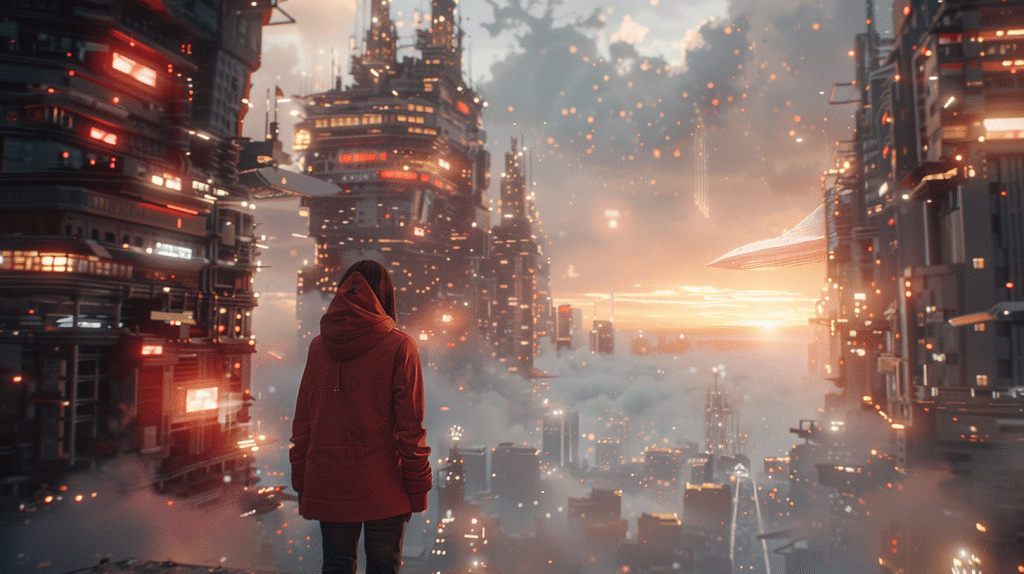
By harnessing the power of visual effects, filmmakers can create magical realism that seamlessly integrates the impossible into the everyday.
You can transform mundane scenes into extraordinary experiences by incorporating surreal elements and dream sequences. Imagine a character walking through a city that slowly morphs into a fantastical landscape, blending reality with imagination.
Visual effects allow you to achieve such impossible shots with technical precision. You can simulate environments and phenomena that can’t be captured on camera, like a character floating in a zero-gravity dream sequence or an entire room turning upside down.
Advanced software, such as Adobe After Effects and Nuke, lets you layer these surreal elements convincingly, maintaining the illusion of realism.
You don’t just add spectacle; you create narrative depth. By embedding these surreal elements, you can explore complex themes and emotions that traditional cinematography might struggle to convey.
Your audience becomes fully immersed in a world where the boundaries between reality and fantasy blur, enhancing their emotional engagement with the story.
In essence, visual effects empower you to push the limits of storytelling. By achieving impossible shots, you make the unbelievable believable, elevating your film to new artistic heights.
Improve Visual Continuity

Ensuring visual continuity often hinges on meticulous attention to detail during the post-production process.
One key technique is color grading, which helps you achieve a consistent look and feel across all scenes. By fine-tuning the hues, saturation, and brightness, you can make certain that the colors match seamlessly, even if the footage was shot under different lighting conditions.
Color grading not only enhances the visual appeal but also aids in maintaining the narrative flow, making each scene feel part of a cohesive whole.
Another vital aspect is managing scene shifts. Smooth transitions are essential for maintaining the story’s rhythm and pacing.
Whether you’re using simple cuts, fades, or more complex digital effects, ensuring that each shift is fluid helps prevent jarring interruptions that can break the viewer’s immersion.
In post-production, you have the tools to finely adjust these shifts, ensuring they complement the overall aesthetic and narrative structure.
Add Creative Elements

When you add creative elements in post-production, you enhance the storytelling impact by weaving in visual cues that support the narrative.
This elevates the visual appeal of your project, making it more engaging and polished.
Enhance Storytelling Impact
Incorporating creative visual effects during post-production can greatly enhance the storytelling impact of your project.
By carefully integrating VFX, you can amplify emotional resonance and add narrative depth, making your story more engaging and memorable.
Visual effects allow you to create worlds, characters, and scenarios that go beyond the limitations of practical effects or live-action shooting, offering endless possibilities for storytelling.
Here are four ways VFX can enhance storytelling:
- Emotionally Charged Scenes: Visual effects can intensify emotions, whether it’s through the subtle enhancement of an actor’s performance or the creation of a dramatic, otherworldly atmosphere.
- Symbolism and Metaphors: Use VFX to visualize abstract concepts, adding layers of meaning that deepen the audience’s understanding and connection to the narrative.
- Smooth Shifts: Smooth shifts between scenes can be achieved with VFX, maintaining narrative flow and keeping viewers immersed in the story.
- Enhanced Realism: Even in fantastical settings, VFX can add realistic details that make the environment more believable, grounding the audience in the story.
Elevate Visual Appeal
By adding creative VFX elements, you can elevate the visual appeal of your project, making it not only more engaging but also visually stunning.
One of the primary techniques you’ll use is color grading. This process allows you to adjust the colors and tones throughout your footage, creating a consistent and visually appealing look.
With precise color grading, you can emphasize mood, highlight essential elements, and guarantee that your project delivers a polished, professional appearance.
Another key technique is texture mapping. This involves applying detailed textures to 3D models, adding depth and realism to your visual effects.
By meticulously mapping textures, you can transform flat, lifeless surfaces into rich, tactile visuals that capture the audience’s attention. Texture mapping can breathe life into environments, characters, and objects, making them more tangible and engaging.
Using these techniques, you’re not just adding random effects; you’re crafting a visual experience that’s both cohesive and enchanting.
Color grading and texture mapping are powerful tools that, when used correctly, can greatly elevate the visual appeal of your project. It’s about transforming your vision into a visually compelling reality that stands out in a crowded media landscape.
Boost Audience Engagement
Enhance audience engagement by infusing your project with innovative creative elements that captivate and inspire. By adding visual effects in post-production, you can transform a mundane scene into a mesmerizing spectacle.
Dynamic shifts and interactive graphics aren’t just eye candy; they serve as critical tools to maintain viewer interest and convey complex information succinctly.
To boost engagement, consider these four elements:
- Dynamic Shifts: Use seamless and visually striking shifts to keep the narrative flow intact while adding an element of surprise. This keeps viewers attentive and excited for what comes next.
- Interactive Graphics: Incorporate graphics that respond to user inputs or adapt as the storyline progresses. This interactivity fosters a deeper connection between the audience and the content.
- Augmented Reality (AR): Integrate AR to create immersive experiences that make your content stand out. This technology allows you to overlay digital elements in the real world, enhancing the storytelling experience.
- Motion Tracking: Apply motion tracking to make sure that your visual effects align perfectly with the live-action footage, creating a cohesive and polished final product.
Correct On-Set Errors
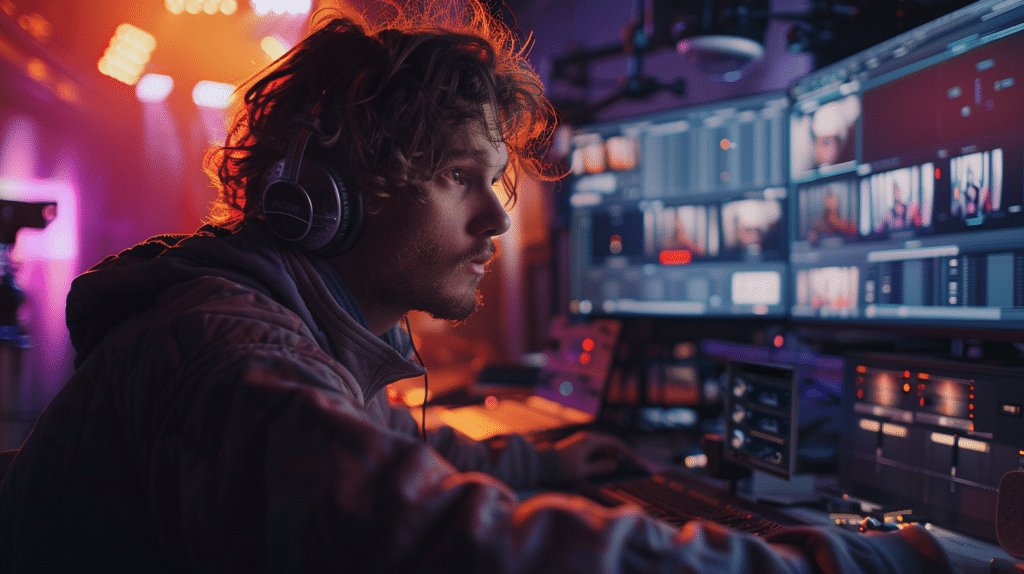
Correcting on-set errors often involves leveraging advanced visual effects techniques to seamlessly integrate fixes into the final footage.
Suppose you encounter inconsistent lighting during a shoot. In that case, lighting correction can be vital to guarantee a uniform look across your scenes.
By adjusting the light levels in post-production, you can rectify any disparities that might’ve occurred due to changing natural light or faulty equipment.
Color grading is another essential tool in your visual effects arsenal. It allows you to alter the color palette of your footage to match a specific mood or aesthetic, rectifying any on-set color discrepancies.
If a scene looks too warm or too cold, you can adjust the hues to achieve a balanced and visually appealing output.
Beyond lighting and color, visual effects can fix other on-set errors like unwanted reflections, misplaced props, or even background elements that disrupt the scene’s continuity.
Increase Production Value

Incorporating sophisticated visual effects into your post-production workflow can greatly enhance the overall production value of your project.
By meticulously blending CGI elements with real-world footage, you create a seamless visual narrative that captivates your audience.
Here’s how visual effects can greatly boost your production value:
- Enhanced Realism: Advanced VFX can simulate natural phenomena, such as weather or fire, which would be costly or dangerous to replicate on set. This enhances the visual realism of your scenes.
- Refined Lighting Techniques: By integrating visual effects, you can adjust and perfect lighting in post-production, ensuring that every scene maintains consistent and ideal lighting conditions.
- Seamless Integration with Sound Mixing: VFX can be synchronized with precise sound mixing to create an immersive experience. For example, adding a visual explosion with corresponding sound effects deepens the impact.
- Expanded Creative Possibilities: VFX allows you to depict scenarios and environments that would be impossible to capture on camera. This opens up limitless creative avenues, from fantastical worlds to futuristic cityscapes.
Engage Audiences

Often, engaging your audience hinges on the effective use of visual storytelling techniques that draw them into your narrative.
By incorporating visual effects in post-production, you can greatly enhance audience retention and guarantee viewer immersion. Complex visual effects like CGI, compositing, and motion graphics can transform mundane scenes into enthralling sequences that hold the viewer’s attention.
Using visual effects allows you to create unique environments and scenarios that would be impossible to achieve during principal photography. Whether it’s a breathtaking space journey or an intense battle scene, these elements can make your story more enthralling.
The more visually stimulating your content, the more likely your audience will stay engaged, and this is vital in an era where viewers have short attention spans.
Moreover, visual effects can subtly guide the viewer’s focus to critical parts of the narrative. Through techniques like color grading and digital enhancements, you can emphasize emotional beats and pivotal plot points, making your storytelling more impactful.
This not only heightens viewer immersion but also deepens their connection to the characters and storyline, fostering a more memorable experience.
Hence, integrating visual effects in post-production is essential for creating a captivating and engaging narrative.
Save Time and Cost

Leveraging visual effects in post-production can dramatically reduce both time and costs associated with reshoots and elaborate set designs.
When you incorporate VFX, you’re optimizing budget management and streamlining resource allocation. Instead of scheduling costly reshoots to capture a perfect scene, you can correct or enhance it digitally. This approach minimizes location fees, actor availability issues, and logistical complexities.
Here are four key ways VFX can save time and cost:
- Eliminates Reshoots: Digital corrections for lighting, color, and minor errors eliminate the need to reassemble cast and crew, saving significant time and money.
- Reduces Set Construction: Creating digital environments and props means you don’t have to build elaborate physical sets, slashing both material and labor costs.
- Speeds Up Production: With VFX, you can shoot scenes faster because you’re not as reliant on perfect conditions or intricate setups, leading to quicker wrap times.
- Optimizes Resource Allocation: By allocating resources to a skilled VFX team, you can avoid the unpredictable expenses associated with on-location shoots and physical effects.
Expand Creative Possibilities

Visual effects open up limitless creative possibilities, enabling you to bring visionary concepts to life that would be otherwise impossible or prohibitively expensive to achieve through traditional filmmaking methods.
By integrating VFX in post-production, you gain unparalleled artistic freedom to craft worlds, characters, and scenes that push the boundaries of imagination.
Whether you’re aiming to create a fantasy domain, futuristic cityscape, or otherworldly creature, VFX allow you to transcend the physical limitations of practical effects.
With VFX, you can engage in innovative experimentation, testing out ideas that might be too risky or impractical to attempt on set. This flexibility lets you refine and enhance your narrative without being constrained by real-world logistics.
For instance, you can simulate complex phenomena like explosions, natural disasters, or intricate landscapes with precision and realism, ensuring your vision is authentically realized.
Moreover, VFX enable you to seamlessly blend live-action footage with computer-generated imagery, creating a cohesive and visually stunning final product. This fusion not only elevates the storytelling but also captivates audiences with its visual splendor.
The technological advancements in VFX provide you with a powerful toolkit to explore new creative territories and produce groundbreaking cinematic experiences.
Frequently Asked Questions

What Software Is Commonly Used for Visual Effects in Post-Production?
Did you know that over 90% of Hollywood blockbusters use Adobe After Effects for their visual effects? When you’re exploring software, Adobe After Effects and Autodesk Maya are industry standards. After Effects excels in 2D compositing, while Maya is unparalleled for 3D modeling.
Both provide powerful tools, but your choice depends on the project’s needs. Explore these software options to elevate your post-production work.
How Do Visual Effects Impact a Film’s Marketing Strategy?
Visual effects greatly impact a film’s marketing strategy by boosting audience engagement and increasing its viral potential. When you incorporate stunning visual elements, you captivate viewers’ attention and make your promotional content more shareable.
High-quality effects create memorable trailers and teasers that can go viral, generating buzz and anticipation. This strategic use of visual effects enhances your film’s visibility and market reach, ultimately driving higher box office performance.
Are Visual Effects Used in Independent Films or Only Big-Budget Productions?
Think of visual effects as the secret sauce in filmmaking. They’re not just for big-budget productions; independent films use them too.
Despite budget constraints, indie filmmakers leverage visual effects for creative storytelling. They often find innovative ways to incorporate them without breaking the bank.
This blend of technical precision and creative insight allows indies to compete with larger studios, delivering visually compelling narratives.
What Skills Are Necessary for a Career in Visual Effects?
To excel in a visual effects career, you need a blend of technical precision and artistic creativity.
Master software like Adobe After Effects and Autodesk Maya, as industry demand is high for skilled professionals.
Strong understanding of animation, compositing, and 3D modeling is essential.
Stay updated with the latest technology trends and develop a keen eye for detail to truly succeed in this competitive field.
How Do Visual Effects Influence the Overall Tone of a Movie?
Visual effects greatly influence a movie’s tone by enhancing color grading and scene composition.
You might think it’s unnecessary, but using visual effects can visually represent complex ideas, making scenes more engaging.
Through precise color grading, you can set the mood, whether it’s eerie or uplifting.
Scene composition with added effects helps in creating a cohesive world, drawing viewers deeper into the narrative with technical precision and creative insight.
Share:
Search our blog:
Follow us on:
